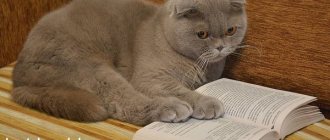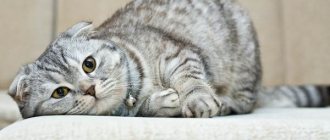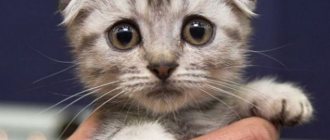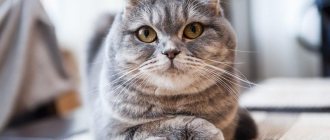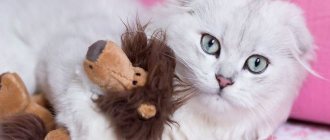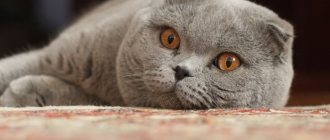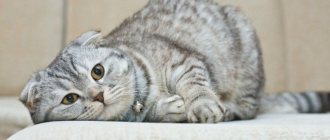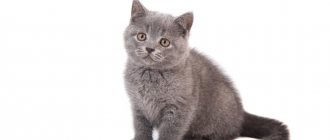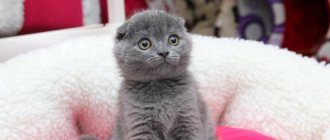| Country of origin | Scotland |
| Wool | short, there is a long-haired variety |
| Dimensions | weight – 3-6 kg, height at withers – up to 30 cm |
| Lifespan | on average 15 years |
The Scottish Fold cat (Scottish Fold) is perhaps the only one that is recognized from dozens of other breeds. And this is thanks to her small hanging ears, pressed tightly to her head. This structure of the ears is the result of a gene mutation and the cause of controversy between felinologists and veterinarians around the world.
Origin story
In 1961, farmer William Ross adopted a kitten from a neighbor with flattened ears, which was born from an ordinary mongrel cat. Snooks, that was the name of Ross's cat, gave birth to kittens with floppy ears. One of them, Snowball, was bred to a British Shorthair. In the litter, 5 fold-eared babies were born at once, who became the founders of the breed.
Initially, the cats were called “lops” - “loop-eared”, but officially in 1966 the breed with folding ears received the name Scottish Fold. “Fold” translated from English means “fold”.
Trying to fix the lop-eared gene, intrabreed matings (fold + fold) were carried out. This provoked the emergence of serious problems with the musculoskeletal system of animals: the bones became shorter, the vertebrae fused together, up to complete immobility. As a result, breeding the Scottish Fold breed in its homeland was banned by the European GCCF.
The second round of development began in the USA. American breeders sought to improve the fit of the ears and make them smaller. At the same time, reduce the risk of hereditary diseases. Therefore, as partners for the Scottish Fold, breeders also chose Scots, but with erect ears - Straights.
In 1974, the Scottish Fold breed was recognized by the CFA and an official description of the external breed data was approved. After 5 years, the Scottish cat took the champion title.
In Europe, the breed developed only in the 2nd half of the 80s. To avoid health problems, European breeders crossed the Scottish Fold with the British Shorthair. As a result, such mating had a bad effect on the condition of these two breeds - too massive folds appeared, with standing hair.
At home, breeding Scottish Folds is not encouraged due to genetic problems. There are still felinological systems that do not recognize the shorthaired fold - FIFe, GCCF. In the USA and Japan the breed is very popular.
Types of Scottish cat
There are 4 types of Scottish cats:
- Scottish fold is a short-haired fold.
- Scottish straight is a short-haired straight-eared breed.
- Highland fold is a long-haired fold.
- Highland Straight is a long-haired, straight-eared breed.
Scottish Straights do not have the lop ear gene, so they do not suffer from genetic diseases associated with skeletal bones and their joints.
Potential Health Problems
The mutated gene, unfortunately, has caused Scottish Folds to be prone to diseases of the musculoskeletal system. Osteochondrodysplasia is most often diagnosed in Scottish Folds. This is a severe hereditary disease characterized by pathology in the development of bone tissue and joints. The main symptoms are lameness, stiffness of gait, soreness of the tail tissues, dwarfism. The disease is rarely fatal, but can lead to serious motor impairments, including complete immobility of the Scottish Fold.
Among hereditary diseases, the Scottish Fold is diagnosed with cardiovascular pathologies, entropion of the eyelids, glaucoma, and polycystic kidney disease. They appear mainly in animals aged 7 years and older.
The ears of the Scottish Fold are susceptible to infection, infestation with ear mites. They should be inspected and treated regularly.
The Scottish Fold needs timely vaccination to help protect against major infectious pathologies, treatment for skin parasites, and deworming. It must be protected from drafts and hypothermia.
Scottish Fold cat: description of the breed
The childish face of the Scottish Fold cat evokes nothing short of tenderness. Because of the large round eyes, short mustache, and flattened ears, the Scottish Fold looks very funny. He is often compared to a child or an owl. Pedigree cats retain their “doll face” throughout their lives.
European and American approaches to breeding are different, but the breed standard for the Scottish Fold cat is the same.
| Become | Characteristic |
| Head | The lines of the head are rounded, like a ball. The flattened ears retain their overall roundness. The smaller the ears and the tighter they are pressed, the better. The tips are rounded. The distance between the ears is large. The eyes are round and set wide apart. The color of the eyes depends on the color of the coat: orange eyes in blue Scottish cats, blue in colored cats, whites, and Vans, green eyes only in gold and silver cats. The whisker pads are well defined and also round. The nose is short, wide, straight. The forehead is convex, so the stop is clearly visible, but there should not be a sharp drop like the Persians. |
| Body | The skeleton is well developed. The body is medium in size. |
| Legs | The limbs are medium in length. Paws are rounded. Well developed fingers. |
| Tail | The tail is long, tapering towards the end. |
| Wool | Short, dense. The undercoat is well defined. WCF and TICA allow any coat color. According to the CFA standard, lilac, chocolate, and colorpoint are not acceptable. |
Breed standards
Scottish Fold breeders focus on two basic standards: the American standard from TICA and CFA, and the European standard from WCF. Both options have an almost identical description of the appearance and body shape. The body of this breed is medium in size with rounded shapes, as well as proportional development in the shoulders and croup.
The head is beautiful and round, set on a short neck, with a strong prominent chin and whisker pads. The nose is short, and at the transition to the frontal part a small depression is allowed. The eyes are round, large and widely spaced. The ears are small, but tightly folded down and forward, while they do not extend beyond the head, so the head appears almost round. The tail can be long or medium in relation to the size of the body. According to American standards, the tail must also be movable.
Important fact! The European standard does not specify requirements for the nature of the coat, compared to the American standards, which provide clear characteristics for both long and short hair. It is indicated that the structure of the coat may depend on climate, season and color, as well as on the living conditions of the animal.
The TICA and WCF standards allow any form of color, while the CFA does not allow colors such as lilac, chocolate, colorpoint, including their combinations with the inclusion of white.
Each standard describes defects that are unacceptable for show class cats. Such defects include:
- Tail too short.
- Other disadvantages of the tail.
- Non-standard number of fingers.
- Problems with the vertebrae that affect tail mobility.
Character and behavior
There are 2 main reasons for the enormous popularity of the Scottish Fold breed - appearance and character. They are affectionate, friendly and loyal cats. Moreover, they do not choose one person in the family, but love everyone. They get along well with children and are not afraid of other animals. They love affection and do not know how to be offended. Such habits are fixed at the genetic level and belong to the advantages of the breed.
The Scottish Fold cat prefers not to show character. It is impossible to anger the Scottish, they are intellectuals. Folds are phlegmatic, not too active, they like quiet games.
But the Scottish need constant contact with people. They need to be close. When the owner is resting, they will happily sit on his lap and purr. When a person does something, a Scotsman will be happy to accompany him everywhere. If the owner is nearby, the Scottish will not be put into a state of stress by moving or changing the environment. But Scottish Folds do not tolerate prolonged separation and loneliness well. Scottish folds are not for busy people.
They are wary of strangers. They prefer to leave to avoid being pestered by strangers.
The breed is distinguished by ingenuity and intelligence, so Scottish Folds quickly learn to use a scratching post, go to the litter box, and follow the rules established in the house. They are difficult to train.
These are general ideas about the character of Scottish folds. But each cat is an individual, so there is other information about the Scots that they are not tame, they show tempers. Breeders exclude cats with bad behavior from breeding, however, even “exemplary” parents may have kittens that are “not a gift.” As a rule, bad character is the result of improper upbringing. After all, to anger a fold-eared cat, you need to be persistent.
Need for care
Any type of content is suitable for the Scottish Fold. He feels comfortable both in a private house, where he can catch mice, and in a cozy city apartment. A small kitten does not require much living space. Before bringing a Scottish Fold into the house, purchase a warm bed, a cozy rest house, several toys, bowls for food and drink, a tray, and a scratching post. Most Scottish Folds are homebodies, but short walks on a harness next to their owner are very useful for them. The Scottish Fold needs at least minimal physical activity. It will help maintain a healthy cardiovascular system.
In order for the Scottish Fold to have an attractive, shiny coat, it requires regular grooming. Mainly, this is combing, which helps get rid of dead hair. In normal times, Scottish Folds are brushed twice a week, and during shedding periods - daily.
To care for the coat of the Scottish Fold, fuminators or special mittens are purchased. Bathing procedures help reduce the amount of hair lost. It is recommended to wash your pet during periods of the most active shedding.
The curled ears of the Scottish Fold require special care. The auditory canals are deprived of air access, which promotes infection. They are regularly inspected and treated with an antiseptic, and then dried. If there are any signs of inflammation, your pet should be taken to the doctor. You cannot use ointments containing antibiotics on your own. It is also useful to wipe the kitten’s eyes with chamomile infusion or a weak solution of boric acid.
The Scottish Fold's claws wear down naturally on the scratching post. It should be high enough so that the animal can sharpen its claws while stretching out to its full height. If necessary, trim the ends with a small nail clipper. To clean teeth, use a children's toothbrush, having previously shortened the bristles.
The Scottish Fold needs plenty of exercise to maintain cardiovascular health. Therefore, walking on a harness will be useful.
What to feed your Scottish Fold? They choose a natural or industrial diet. Veterinarians do not recommend mixing food of two different types, as this can lead to overload of the enzymatic system.
A natural diet includes, in addition to meat ingredients (which make up up to 70% of the diet), the following products:
- Low-fat sea fish (hake, salmon, navaga, tuna, flounder).
- Fermented milk products (bio-yogurt, cottage cheese, kefir, fermented baked milk).
- Chopped vegetables (pumpkin, zucchini, cabbage, carrots, beets).
- Cereals (buckwheat, millet, oats, wheat, semolina). For adult cats, liquid porridge is cooked in water, with the addition of a spoonful of vegetable oil.
- Chicken egg yolks or quail eggs.
As for commercial diets, the Scottish Fold will benefit from high-quality holistic or super-premium food, where the composition is maximally balanced and diverse in microelement composition. Breeders recommend the following brands:
- AATU;
- Applaws;
- Canagan;
- Natural;
- Leonardo;
- Mealfeel;
- Meowing Heads.
You should not feed your Scottish Fold food from your table that contains too much fat, sugar and preservatives. Scottish Folds are prone to overeating, so portion sizes are controlled according to age. Excess weight has a negative impact on pets and can provoke the development of many dangerous pathologies.
Care and maintenance
Caring for the Scottish Fold breed is not difficult. These are standard steps that apply to all smooth-haired cats:
- Trimming nails as needed. Use special nail clippers.
- Combing the coat – once a week. During molting - 2 times. A wide-toothed comb, a mitten for combing short-haired animals, and a natural bristle brush are suitable. If the tail looks good, leave it alone. Tail hairs are easily pulled out but difficult to grow back.
- Rubbing eyes and ears. Clean your ears from wax and plaque once a month (on average). Inspection for ear mites is carried out weekly. The eyes are wiped with a cloth soaked in water every day.
- Teeth cleaning. People are accustomed to the procedure from infancy. An adult cat will strongly resist. Use paste and brush from a veterinary pharmacy. There are special toys on sale that get rid of plaque.
- A Scottish Shorthair cat should be bathed only if it is heavily soiled (show animals are an exception). Some Scottish dogs love water and are happy to allow themselves to be washed once a month.
Content Features
Typically, breeders give kittens to new owners at the age of 12–16 weeks. By 4 months, the animals have already received all the basic vaccinations, they are physically and emotionally stable, ready to live without their mother and adapt to new owners. But still, fluffies need your care, and they need to be taught important procedures from childhood.
Care
Cats do a great job with their hygiene on their own, but they still need help with some things. Scots need to be combed once a week, long-haired folds - every other day. Use a furminator and accustom the kitten to the procedure from childhood so that he gets used to brushing. For more frequent combing, a comb is suitable.
Long-haired Scottish Folds require regular brushing.
They don't shed too much, so there won't be any problems with hair throughout the house. However, in the fall, when the air becomes drier, and traditionally in the spring, cats shed more.
There is no point in cutting your cat's hair. Despite the fluffy coat, the animal does not experience problems with overheating. On the contrary, wool serves as a temperature regulator for her at any time of the year.
You need to trim your claws as needed; there are special nail clippers for this. Be sure to buy a scratching post and teach your kitten to use it. A good scratching post is not just a place where your cat gets her nails done. Here she also warms up, stretches and realizes her hunting instincts by extending and thrusting her claws. If the scratching post cannot cope with reducing the length of the claws, they can be cut once every three weeks.
Scotch cats need to be bathed in the same way as ordinary cats - when they get dirty, and this happens very rarely. The pet does not need to be washed more than two or three times a year. At the same time, you can wash the cat “in parts” if there are difficulties with the litter box. This is especially true for fluffy cats.
Examine your eyes daily, remove accumulated secretions in the corners using special wet wipes. The ears also need to be cleaned - once every 2-3 weeks, using a product and a cotton swab. Cotton swabs are too rough and can damage delicate skin.
Animal behaviorists recommend providing your pet with a large litter box and litter in which to dig. Silica gel or wood gel works well. It is not recommended to accustom a cat to the toilet - the load on the paws and constant stress are not worth saving space and money on litter.
Recently, veterinary dentists have recommended brushing cats' teeth at home at least once a week. This can be done using a bandage, a special brush and paste, which is sold in a pet store. Hygiene products for humans are not suitable for predators. Dry food doesn't clean teeth - it's a marketing ploy. But natural food does the job well - the cat gnaws chicken necks and pieces of meat. Her teeth are cleaned mechanically and strengthened from the inside thanks to a balanced composition. Plaque and bad breath disappear.
Feeding
To prevent joint dysplasia, it is important to feed your cat properly, choose a source of complete protein and not overdo it with carbohydrates. Scottish Folds are also predators, so the best solution for them would be a natural, species-specific diet. Biologically appropriate food SUPERPET contains everything necessary for the healthy growth and development of a kitten; it can be given to kittens from 1.5–2 months.
The SUPERPET species-typical diet includes high-quality meat, meat and bone components with a balanced ratio of calcium and phosphorus, taurine, vitamins, Omega-3, offal and some vegetables. Nutrition replicates the prey of a predator in the wild, improves health and prevents disease.
Veterinary examinations and procedures
You need to visit a veterinarian once a year if your cat does not have chronic diseases. Prevention against parasites should be carried out once a quarter. Even if the cat lives in an apartment and does not go outside, you can bring invisible worm larvae and fleas on shoes and clothes. The same applies to vaccinations - vaccination should be annual.
It is especially important to regularly visit a veterinarian for pets who are predisposed to brachycephalic syndrome. The doctor will help determine the need for surgery and will pay attention if something has changed in the animal’s behavior.
How are British cats different from Scottish cats?
These breeds are often confused. Some even believe that there is a breed of British Fold cat. Indeed, until 2006 it was possible to crossbreed British and Scottish cats, but now this is prohibited.
In the 90s, when the fashionable breed first came to Russia, unscrupulous breeders began crossing Scottish Folds with British ones. This is how the myth about British Fold cats appeared, although such a breed does not exist, and only a few individuals survived as a result of crossing. The dangerous gene for lop ears, when mixed with the large, heavy bones of the British, causes severe pathology.
Scottish and British are two different breeds. The Scots appeared as a result of a mutation of the British cat, so they are similar in appearance. Moreover, the smoky color of Scottish cats, characteristic of the British, can be misleading.
This is a Scottish Fold cat with a lilac color, which is often found among the British.
You can tell a kitten apart by its ears. Scottish cats come in straight ears (Scottish Straight) and fold ears (Scottish Fold). Individuals with folded ears are always Scots. The British are always straight-eared.
The shape of the ears will help to distinguish Scottish Straights from British ones: Scots have longer and sharper ears, and sometimes stand right above the eyes, making the face cute. British cats have wider ears. There is also a difference in the structure of the neck: in this breed it is denser and wider. And the British cats themselves are more plump and larger than the Scottish cats, which look more graceful. The head is smaller relative to the body.
The fur of British cats is denser, always short, and plush. Scottish dogs are softer and fluffier, and among them there are long-haired individuals - they even participate in exhibitions in a separate category.
And there are differences in character. The British are more phlegmatic and calm. Many of them are unfriendly. Scottish cats have fewer behavioral problems - they are softer both in coat and in character. And the British never sit in the meerkat pose.
Health
Scottish Fold cats cannot be called sickly animals. However, there are health problems inherent to the breed:
- Osteochondrodystrophy (OCD) is a disease that is inherited. Characteristic: non-correction of the tail due to fused vertebrae, curvature of the limbs (X legs), malocclusion, bumps on the skull. The main reason for its appearance is the crossing of two fold-eared cats.
- Hemophilia is a blood clotting disorder.
- Cardiomyopathy is a heart disease. A common pathology in many breeds.
A predisposition to a specific disease does not mean that it will necessarily manifest itself.
In the absence of hereditary pathologies and proper care, Scottish Fold cats can live up to 20-22 years. On average, Scottish cats live 15 years.
Proper nutrition is the key to health
Fold-eared Scots are real gluttons. According to breeders, pets are ready to eat a double portion in one sitting. An insatiable appetite often leads to weight gain, and obesity can affect your health. This must be taken into account when planning your diet. Veterinarians advise switching Scottish Folds to super-premium or holistic dry industrial formulas. Feeding is done in the morning and evening in the dosage recommended by the manufacturer.
Those who prefer to feed their cat natural food need to remember one rule - approximately 80% of the diet is meat, and the remaining 20% are supplements in the form of cereals, vegetables, eggs, and cottage cheese.
The table below shows foods that you can and cannot feed your Scottish Fold cat. Table - Allowed and prohibited products for Scottish Fold
| Can be included in the diet of Scottish Folds | Foods you should not feed your Scottish Fold |
| Rabbit meat | Potato |
| Chicken fillet | Beans |
| Lean parts of turkey | Pork |
| Veal | Salo |
| Beef | Bread, rolls |
| Sea fish | Snacks |
| Eggs (preferably yolk) | Salty food |
| Vegetables – broccoli, spinach, carrots | Sweets |
| Porridge – rice, buckwheat, oatmeal | Bones |
| Dairy products | Whole milk |
| By-products | Canned food |
Nurseries
The Scottish Fold is one of the most popular breeds, including among breeders. Therefore, there are enough nurseries where you can buy a fold-eared kitten.
Moscow:
- Shen-Alin, shen-alin.jimdo.com
- Lovely LapaTan, lapatan.ru
- Anthology, scottish-cat.com
- SuperFold, superfold.ru
- Mikaella, brimik.ru
Nurseries are registered in the WCF system.
Saint Petersburg:
- INTENSITY, s-fold.ru LifeJoy, lifejoycat.ru
- SNOW CITY, snow-city.ru
- STYLE JASMINE, style-jasmine.ru
How to choose a kitten
The Scottish Fold is a difficult breed to breed. Therefore, you can only buy a purebred kitten in a nursery or at an exhibition.
If you are only interested in the Scottish Fold, then you should take into account that kittens are born with normal ears. At 3-4 weeks the ears lie down or remain straight. At this age, you can choose a kitten from a photo if you cannot visit the nursery. The baby is taken away at the age of 3-4 months, when the first vaccinations are done and the pet is accustomed to the tray.
It is necessary to ask the breeder for an inspection certificate from the parents of the small Scottish Fold so that there is permission for breeding. If the parents have titles, this is a guarantee that the kittens will meet the standard requirements.
When choosing a kitten, I recommend paying attention to the following:
- The tail is movable, touching it does not cause discomfort.
- The paws are not rough.
- Kittens from the same litter should not stand out - be too plump or, on the contrary, thin.
- They are accustomed to being handled and are not afraid of people.
- There should be no discharge from the eyes and ears, and the area under the tail should be clean.
If a male or female cat is castrated/sterilized, then their character and habits will not differ much. However, it is believed that girls are smarter than cats, more independent, focus all their attention on only one person, and treat other family members favorably.
Adding to the family: how to care for a mother and her newborns
In the first weeks after the birth of kittens, providing proper care is the key to healthy babies and cats. The list of necessary actions on the part of the owners is as follows:
- Provide a warm, dry box for mother and kittens.
- Place a white sheet over it to help track your cat's waste.
- Provide your cat with a balanced diet.
- Organize constant access to water for babies and mothers.
- Do not try to separate the kittens from the cat.
The last point determines the development of the kitten and its viability. If you separate small pets from their parents, you can cause physical harm to them, because the bones are still fragile during this period, deprive the kittens of milk, which is responsible for their immunity, and disrupt their psychological state.
Creating favorable conditions for cats and newborn kittens
Facts about Scottish Fold cats
Scottish Folds have their own breed characteristics:
- The Scotsman's voice is different from the usual purring - a little creaky, low. He serves it on rare occasions: when he is very hungry, finds himself locked in a closet, or if something hurts.
- The Scottish Fold easily assumes the meerkat pose and can stand on its hind legs for quite a long time. And he likes to sleep on his back.
- The Scottish cat prefers to sit like a person. At the same time, the cat stretches its hind legs forward and places its front legs on its stomach.
- Fold-eared cats are afraid of heights due to the structural features of the vestibular apparatus.
- The mutation that led to the appearance of the fold in the ear also affects other cartilage in the body. Therefore, if mated incorrectly, kittens may be born that develop arthritis at an early age.
Life expectancy - how long do Scottish Folds live?
With excellent care, the Scottish Fold can live a long, active life. The average duration is from 15 to 18 years. Since the Scottish Fold is an artificially bred breed, the influence of genes on health, and therefore on life expectancy, is quite large. Unfortunately, the Scottish Fold is characterized by a tendency to a number of genetic pathologies. The kitten receives these diseases of the breed from its parents and earlier ancestors. That's why choosing a future pet should begin with getting to know its father and mother.
A proper lifestyle for the health of the Scottish Fold is extremely important. The pet must exercise enough and eat properly. In addition, injuries and stress should be excluded. If any problems arise, it is important to immediately contact a veterinarian in order to diagnose pathologies at an early stage.
Advantages and disadvantages
Fold cats are favorites of famous personalities. They write books on them and run YouTube channels.
Advantages:
- High level of intelligence.
- Feel the mood of the owner.
- Clean.
- They do not show aggression or revenge.
- Kind and cheerful.
Disadvantages of the breed:
- They do not tolerate loneliness well.
- Raising an obedient cat is not an easy task.
- They can show whims.
- They do not like to be cuddled and only a few like to be held.
British or Scottish cat: which one to choose?
Scottish fold cat
How to name a British and Scottish kitten >> How to name a kitten based on the length of its fur >>
Despite the fact that the British and Scots have a fairly similar appearance and rules for caring for them, the nature of the animals has clear differences:
- Relationship with the owner. British cats love to be alone and do not particularly need attention to their aristocratic persona. But the Scots prefer good communication with their favorite breadwinner and often ask to be held and stroked.
- Relationships with children. Both cat breeds love active play and get along well with children in the house. However, the British woman does not like excessive intrusiveness in those moments when she wants to be alone. Of course, she won’t scratch the little “robber”, but she will still try to hide. According to most owners, Scottish Fold cats are best suited for families with children, as they are ready to play all day long, never showing negative emotions.
- Unusual habits. Representatives of the Scottish cat breed can often stand in a “column” position, as well as sit on their butt. And although from the outside this behavior may seem like funny pampering, pets are simply stretching their vertebrae in this way. The British, as a rule, are not endowed with such a habit.
- Fear of heights. Most Scottish Folds, due to the special structure of the vestibular apparatus, are very afraid of heights. Therefore, despite the fact that animals love to have fun for a long time, they will never jump on the curtains and tear the chandelier from the ceiling. But British cats quite often climb higher to observe the situation in the house from above. By the way, at the same time they always put on the imperturbable face of the leader of the pack!
Straight-eared Scottish cat
Types of British cats >> Mating, pregnancy, birth of British cats >>
Best articles: Beautiful nicknames for girl puppies. What name should you choose for your dog?
To finally decide which one to choose, we recommend that you familiarize yourself with the following tips:
When choosing a pet, hold a Scottish Fold and a Scottish Fold kitten in your arms. Feel the difference in the quality and length of the coat. Carefully examine and compare the appearance of the animals. Don't forget that British Folds don't exist! When purchasing any kitten, make sure that its immediate family members are of the same breed. Scottish cats, like British ones, do not allow crossing with other breeds. In addition, to breed a Scottish cat, one of the parents must be fold-eared and the other must be straight-eared. Other mating can lead to defects at the genetic level
You will never find a mixture of British and Scots in a decent nursery of purebred mustaches
Pay attention to the cost of animals. As a rule, visloushki are somewhat more expensive
But another indicator can also be documentary evidence of the purity of the breed, pedigree, color of the pet and its class (show, breed or pet). To avoid being deceived about the breed or being sold a mongrel kitten, buy an animal from a nursery that the club or a good friend will recommend to you. It is less safe to buy from the British, but only in the sense that they are more likely to have no musculoskeletal diseases.
British cat care and maintenance >> What does a British cat look like >>
The main similarity between the two plush breeds is that you will love each of them selflessly. And when making your choice in favor of one of the pets, be guided by your heart. This is what will help you find a devoted and obedient friend for many years.
